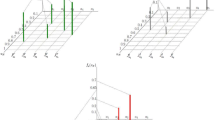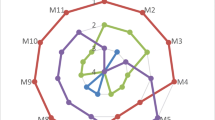Abstract
Linguistic neutrosophic number (LNN) can describe evaluation information by three linguistic variables indicating truth-membership, indeterminacy-membership and falsity-membership respectively, which is an effective tool to represent uncertainty, the partitioned Maclaurin symmetric mean (PMSM) operator can reflect the interrelationships among criteria where there are interrelationships among criteria in the same partition, but the criteria in different partitions are irrelevant, so, in this paper, we extend the PMSM operator to LNNs, define linguistic neutrosophic partitioned Maclaurin symmetric mean operator and linguistic neutrosophic weighted partitioned Maclaurin symmetric mean (LNWPMSM) operator, and discuss the properties and theorems of the proposed operators. Then we propose a clustering algorithm for linguistic neutrosophic sets based on the similarity measure to give some objective and reasonable partitions among criteria, and based on the LNWPMSM operator and the objective partition structure of the criteria, a novel multi-criteria group decision-making method is developed for linguistic neutrosophic environment. Finally, one practical example is presented to illustrate the applicability of the proposed method, and a comparison analysis is to show the advantages of the proposed method compared with the existing methods.

Similar content being viewed by others
References
Bai KY, Zhu X, Wang J, Zhang R (2018) Some partitioned maclaurin symmetric mean based on q-rung orthopair fuzzy information for dealing with multi-attribute group decision making. Symmetry 10(9):383
Bouraoui A, Jamoussi S, BenAyed Y (2018) A multi-objective genetic algorithm for simultaneous model and feature selection for support vector machines. Artif Intell Rev 50(2):261–281
Chen SM (1988) A new approach to handling fuzzy decision making problems. IEEE Trans Syst Man Cybern 18(6):1012–1016
Chen SM, Hsiao PH (1995) A comparison of similarity measures of fuzzy values. Fuzzy Sets Syst 72:79–89
Chen ZC, Liu PH, Pei Z (2015) An approach to multiple attribute group decision making based on linguistic intuitionistic fuzzy numbers. Int J Comput Intell Syst 8(4):747–760
Deng G, Jiang Y, Fu J (2015) Monotonic similarity measures between intuitionistic fuzzy sets and their relationship with entropy and inclusion measure. Inf Sci 316:348–369
Dutta B, Guha D (2015) Partitioned Bonferroni mean based on linguistic 2-tuple for dealing with multi-attribute group decision making. Appl Soft Comput 37:166–179
Fang ZB, Ye J (2017) Multiple attribute group decision-making method based on linguistic neutrosophic numbers. Symmetry 9(7):111
Harsanyi JC (1955) Cardinal welfare, individualistic ethics, and interpersonal comparisons of utility. J Polit Econ 63(4):309–321
Jin L, Mesiar R, Qian G (2018) Weighting models to generate weights and capacities in multicriteria group decision making. IEEE Trans Fuzzy Syst 26(4):2225–2236
Li C, Wang K, Xu N (2019) A survey for the applications of content-based microscopic image analysis in microorganism classification domains. Artif Intell Rev 51(4):577–646
Liang WZ, Zhao GY, Wu H (2017) Evaluating investment risks of metallic mines using an extended TOPSIS method with linguistic neutrosophic numbers. Symmetry 9(8):149
Liu PD, Chen SM (2017) Group decision making based on Heronian aggregation operators of intuitionistic fuzzy numbers. IEEE Trans Syst Man Cybern 47(9):2514–2530
Liu P, Liu J (2018) Some q-rung Orthopai fuzzy Bonferroni mean operators and their application to multi-attribute group decision making. Int J Intell Syst 33(2):315–347
Liu P, Tang G (2019) Some intuitionistic fuzzy prioritized interactive Einstein Choquet operators and their application in decision making. IEEE ACCESS 6:72357–72371
Liu PD, Wang P (2018) Multiple-attribute decision making based on archimedean Bonferroni operators of q-rung orthopair fuzzy numbers. IEEE Trans Fuzzy Syst. https://doi.org/10.1109/tfuzz.2018.2826452
Liu P, Zhang X (2018) Approach to multi-attributes decision making with intuitionistic linguistic information based on Dempster–Shafer evidence theory. IEEE ACCESS 6(1):52969–52981
Liu PD, Chen SM, Wang P (2018a) Multiple-attribute group decision-making based on q-rung orthopair fuzzy power maclaurin symmetric mean operators. IEEE Trans Syst Man Cybern. https://doi.org/10.1109/tsmc.2018.2852948
Liu PD, Liu J, Merigó JM (2018b) Partitioned Heronian means based on linguistic intuitionistic fuzzy numbers for dealing with multi-attribute group decision making. Appl Soft Comput 62:395–422
Liu PD, Mahmood T, Khan Q (2018c) group decision making based on power Heronian aggregation operators under linguistic neutrosophic environment. Int J Fuzzy Syst 20(3):1–16
Maclaurin C (1729) A second letter to Martin Folkes, Esq concerning the roots of equations, with demonstration of other rules of algebra. Philos Trans Roy Soc London Ser A 36:59–96
Majumdar P, Samanta SK (2014) On similarity and entropy of neutrosophic sets. J Intell Fuzzy Syst 26(3):1245–1252
Mann S, Singh S (2019) Improved artificial bee colony metaheuristic for energy-efficient clustering in wireless sensor networks. Artif Intell Rev 51(3):329–354
Melin P, Sanchez D (2018) Multi-objective optimization for modular granular neural networks applied to pattern recognition. Inf Sci 460:594–610
Meng F, Tang J, Fujita H (2019) Linguistic intuitionistic fuzzy preference relations and their application to multi-criteria decision making. Inf Fusion 46:76–90
Morente-Molinera JA, Kou G, Gonzalez-Crespo R, Corchado JM, Herrera-Viedma E (2017) Solving multi-criteria group decision making problems under environments with a high number of alternatives using fuzzy ontologies and multi-granular linguistic modelling methods. Knowl Based Syst 137:54–64
Pecaric J, Wen J, Wang WL, Lu T (2005) A generalization of Maclaurin’s inequalities and its applications. Math Inequal Appl 8(4):583–598
Pedrino EC, Yamada T, Lunardi TR, Vieira JCD (2019) Islanding detection of distributed generation by using multi-gene genetic programming based classifier. Appl Soft Comput 74:206–215
Qin J, Liu X (2014) An approach to intuitionistic fuzzy multiple attribute decision making based on Maclaurin symmetric mean operators. J Intell Fuzzy Syst 27(5):2177–2190
Safdar S, Zafar S, Zafar N, Khan NF (2018) Machine learning based decision support systems (DSS) for heart disease diagnosis: a review. Artif Intell Rev 50(4):597–623
Salabun W, Piegat A (2017) Comparative analysis of MCDM methods for the assessment of mortality in patients with acute coronary syndrome. Artif Intell Rev 48(4):557–571
Wang WJ (1997) New similarity measure on fuzzy sets and on elements. Fuzzy Sets Syst 85(3):305–309
Wang Y, Liu PD (2018) Linguistic neutrosophic generalized partitioned Bonferroni mean operators and their application to multi-attribute group decision making. Symmetry 10(5):160
Wu X, Liao H, Xu Z, Hafezalkotob A, Herrera F (2018) Probabilistic linguistic MULTIMOORA: a multi-criteria decision making method based on the probabilistic linguistic expectation function and the improved Borda rule. IEEE Trans Fuzzy Syst 26(6):3688–3702
Xu ZS (2006a) Induced uncertain linguistic OWA operators applied to group decision making. Inf Fusion 7:231–238
Xu ZS (2006b) Dependent uncertain ordered weighted aggregation operators. Inf Fusion 9(2):310–316
Xu ZS (2007) Intuitionistic preference relations and their application in group decision making. Inf Sci 177:2363–2379
Xu ZS, Xia M (2011) Distance and similarity measures for hesitant fuzzy sets. Inf Sci 181:2128–2138
Xu ZS, Chen J, Wu JJ (2008) Clustering algorithm for intuitionistic fuzzy sets. Inf Sci 178:3775–3790
Yager RR (1988) On ordered weighted averaging aggregation operators in multi-criteria decision making. IEEE Trans Syst Man Cybern 18(1):183–190
Yager RR (2001) The power average operator. IEEE Trans Syst Man Cybern A Syst Hum 31(6):724–731
Yang W, Pang Y (2018) New pythagorean fuzzy interaction Maclaurin symmetric mean operators and their application in multiple attribute decision making. IEEE Access 6:39241–39260
Zadeh LA (1965) Fuzzy sets. Inf Control 8(3):338–356
Zadeh LA (1975) The concept of a linguistic variable and its application to approximate reasoning, part I. Inf Sci 8(3):199–249
Zhang Y, Bai X, Fan R, Wang Z (2019) Deviation-sparse fuzzy C-means with neighbor information constraint. IEEE Trans Fuzzy Syst 27(1):185–199
Acknowledgement
This paper is supported by the National Natural Science Foundation of China (Nos. 71771140 and 71471172), and the Special Funds of Taishan Scholars Project of Shandong Province (No. ts201511045).
Author information
Authors and Affiliations
Corresponding author
Additional information
Publisher's Note
Springer Nature remains neutral with regard to jurisdictional claims in published maps and institutional affiliations.
Rights and permissions
About this article
Cite this article
Liu, P., You, X. Linguistic neutrosophic partitioned Maclaurin symmetric mean operators based on clustering algorithm and their application to multi-criteria group decision-making. Artif Intell Rev 53, 2131–2170 (2020). https://doi.org/10.1007/s10462-019-09729-0
Published:
Issue Date:
DOI: https://doi.org/10.1007/s10462-019-09729-0




